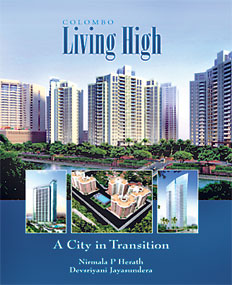
Feel the pulse of a city on the makeColombo Living High: A City in Transition by Nirmala P. Herath and Devsriyani Jayasundara. Published by the Institute of Town Planners and printed by Mithuru Printers, Kelaniya. Reviewed by Prof. Willie Mendis Except for government reports and a smattering of feature articles, there has been a scarcity of publications relating to changes in the physical fabric of the city of Colombo. The authors of Colombo: Living High have attempted to fill this gap with their scholarly study, making this a collector’s item for Sri Lankans here and abroad. Prudently, the writers assert that the cityscape will continue to evolve, and that Colombo will be a city in transition. Their well-researched and presented study traces in a sequence of seven sections the city’s physical evolution. Illustrations, statistics and charts offer the more serious student of urban affairs plenty of material for a deep analytical study.
Part 1 covers the city’s colonial heritage and its direct relevance to the city’s flooding problems. The authors claim that Colombo, from a topographical point of view, is not a suitable site for urban development. They point to the city’s location on the floodplain of the Kelani River, much of which has turned into wetland. For now, what protects the city from heavy flooding is the bund built by the British in 1925. This bund has helped to secure a vast extent of land for development. On the other hand, the authors say that Colombo was a well-established urban settlement as far back as the 8th century AD, centuries before the arrival of the first European colonial powers. An absence of historical references to flooding during these early times suggests that a much smaller city would have developed, essentially on the highlands, in harmony with nature. According to the authors, available records indicate that the city of those days would have been only six hectares in extent. The colonial legacy of buildings, streets and harbour spanning the Portuguese, Dutch and British eras reflects a continuum of city development up to present times. This legacy underscores the strong connection between the city’s physical landscape and its role in the development of the economy, providing a key lesson from history for today’s city planners. In Part II, the writers trace the story of past efforts to manage changes in the city’s physical fabric. The complexities involved in city planning are further complicated by rapid changes happening in the economy. The writers believe that the only way to manage change is through a legally enforceable Physical Plan. City planning and building, say the authors, who write with an expertise and confidence based on their considerable experience in urban development, should reflect a sensitive balancing of the different forces that interact to make the city. This book should be an eye-opener to not only city planning professionals but also entrepreneurs, government and business organisations and the average citizen. The book shows how we can all be proactive stakeholders in the development of our city. Part III profiles the city’s expansion in terms of demographic changes. Colombo is the island’s most densely populated city, as a result of a continuously growing city economy, ongoing improvements to the city infrastructure, and heavy public and private sector investment in high-rise condominiums. The writers believe the city’s land is under-utilised, and that the way forward is through regeneration of these “brown areas”. A thrust in this direction will be the launch of the Panchikawatte Triangle Project. Further densification will be a continuing trend. Part IV focuses on the factors that have driven the building of high-rises in Colombo city. The City of Colombo Development Plan 1999 embodies a vision for the city as “the financial and commercial hub of South-East Asia”. The plan promotes high-rise development within the context of a garden city. The book looks closely at the entire web of features connected with high-rises. Photo-images of Colombo’s high-rises show the city’s changing skyline as no other related publication has done so far. Part V looks at the positive and negative impact of the city’s high-rise development. The challenges of planning and the prospects of urban regeneration are comprehensively discussed. Going through the book’s “City Album”, a large portfolio of recent photographs, the reader can feel the pulse of a city in transition. The future for high-rises is covered in the final part, titled “Developers’ Dream”. Real estate players and entrepreneurs would love this section. The handsomely produced 233-page publication, serving as a mirror of urban Sri Lanka, would appeal to a wide spectrum of Sri Lankans, resident in the country or living overseas, and to anyone with an interest in the country. (The reviewer is Professor Emeritus, University of Moratuwa) |
|
||||||
|| Front
Page | News | Editorial | Columns | Sports | Plus | Financial
Times | International | Mirror | TV
Times | Funday
Times || |
| |
Reproduction of articles permitted when used without any alterations to contents and a link to the source page.
|
© Copyright
2008 | Wijeya
Newspapers Ltd.Colombo. Sri Lanka. All Rights Reserved. |
